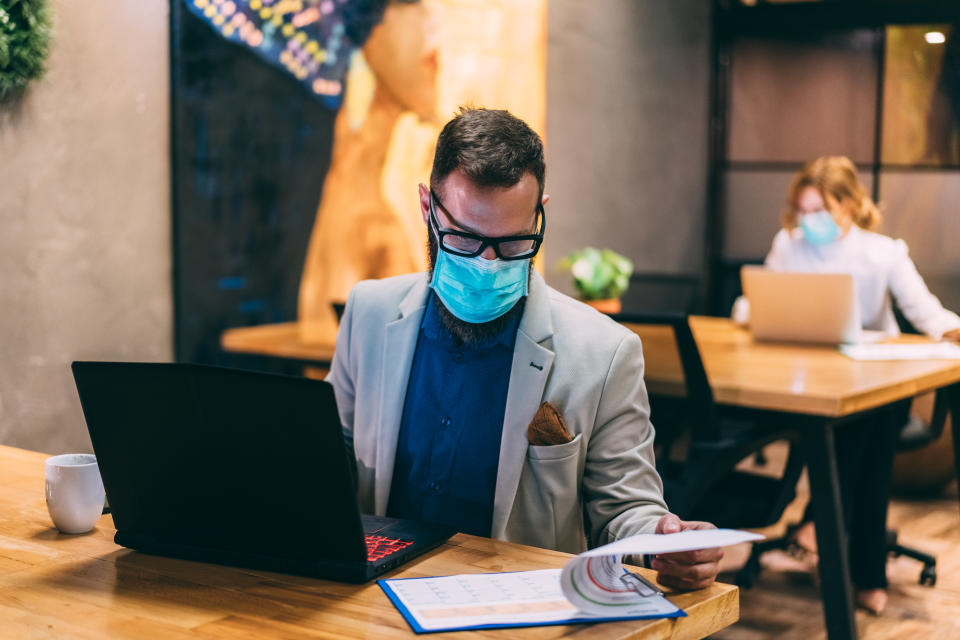What do you do if your employee isn't social distancing?

Since the start of August, employers in England have had more freedom to decide how staff should work, whether at home or in the workplace. But in the last few weeks, ministers have been actively promoting returning to offices and other workplaces to help boost trade to local businesses that relied on workers passing by.
Before employees can return to workplaces, there are a number of safety measures to be put in place. One-way systems should be introduced to minimise contact, objects and communal areas should be frequently cleaned and people should observe the “one-metre plus” rule of social distancing, among other precautions like wearing face coverings or increasing ventilation indoors.
But what should employers do if a member of staff is refusing to social distance — and putting others at risk?
READ MORE: Why forcing people to turn on their Zoom cameras isn't inclusive
“With the global pandemic still playing a significant role in people’s lives, unfortunately some individuals are getting complacent when it comes to social distancing and mask-wearing,” says Andrew Willis, head of legal at the HR and employment law firm Croner.
“This means that even if you’ve set out a perfect plan to make your workplace COVID-secure, it may not matter. The health and safety of your employees is your responsibility, even if they’re the ones putting themselves and others at risk.”
Firstly, it’s important to make sure you’ve carried out a risk assessment and put all the relevant safety measures in place before asking employees to return to work.
READ MORE: Is a noisy office ever a good thing?
“Have you marked floors to highlight two-metre distances? Have you installed hand sanitising stations? Finally, have you communicated all the measures to your employees? Are they aware of them? If your answer to any of these questions is ‘no’ you should address them before penalising staff,” Willis says.
If you’re certain you’ve done everything correctly, the next step is to have a conversation with the employee. Make sure they know it’s essential they maintain distance from other employees for their own safety and the safety of other people. Sometimes, it can be easy to forget to stay apart from others when you’re back at the office and things seem more normal.
Inform the employee that failure to comply with the measures you’ve set out may be an act of gross misconduct. “Ultimately, their behaviour could lead to dismissal. Hopefully, this alone should be enough to persuade them to follow your health and safety guidelines,” Willis explains. “If it isn’t, then you need to proceed down a more serious disciplinary route.”
As with any disciplinary, you have to follow the correct procedure or risk a claim to unfair dismissal.
“Begin with an investigation into the misconduct. It may be necessary to suspend the employee if their presence will interfere with the investigation. Once finished, you should send out a letter to the employee informing them of the allegations and next steps,” says Willias.
“Don’t make any sanctions during the hearing. The purpose of this meeting is to determine if the employee breached your health and safety measures,” he adds. “Once the meeting is over, you decide whether — based on the evidence — the allegations are true. If yes, you may then decide to dismiss the employee. Employees have the right to appeal against this decision, and you should remind them of this.”
Watch: How To Resign Without Burning Bridges
READ MORE: What is reverse mentoring and can it work for businesses?
Sometimes it seems easier to turn a blind eye to a worker who is ignoring safety precautions. But with cases of COVID-19 on the rise in the UK, it’s vitally important to make sure everyone is sticking to the rules.
“Failure to act when an employee breaches your COVID-secure measures sets a precedent for others to follow suit and demonstrates a failure to comply with your duty of care towards both employees and non-employees,” Willis says.
“Remember, failure to protect your employees is on you and you can be vicariously liable by your employees' actions or failures. This can result in significant fines from the HSE or worse — an outbreak among your staff.”

 Yahoo Finance
Yahoo Finance 
